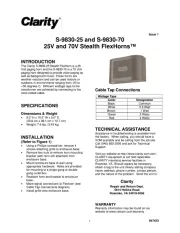QSC LA108 Handleiding
Bekijk gratis de handleiding van QSC LA108 (2 pagina’s), behorend tot de categorie Speaker. Deze gids werd als nuttig beoordeeld door 45 mensen en kreeg gemiddeld 4.2 sterren uit 23 reviews. Heb je een vraag over QSC LA108 of wil je andere gebruikers van dit product iets vragen? Stel een vraag
Pagina 1/2

RIGGING
Deutsch
Befestigungselemente
1 Vordere Anschlagpunkte zur Befestigung
eines darüber liegenden Lautsprechers
oder an einem Flugrahmen.
2 Vordere Haken zur Befestigung der
Anschlagpunkte eines darunter liegenden
Lautsprechers oder
Groundstack-Adapters.
3 Rückseitige Haken zum Arretieren des
darunter liegenden Lautsprechers. Diese
Haken müssen zur Sicherung verwendet
werden, wenn zwei oder mehr
Lautsprecher gestacked oder im Array
geflogen werden.
4 Der Verriegelungshebel
besitzt 3 Positionen:
• Oben: Lautsprecher
vom Array entriegeln
• Mitte: Lautsprecher zur
Befestigung vorbereiten
• Unten: Lautsprecher in
der Position verriegeln
Winkel einstellung
5 Durch Betätigen der Winkelentriegelung
kann die Winkelschiene (7) zur nächsten
verfügbaren Position bewegt werden. Die
Winkelentriegelung muss sich nach dem
Einstellen des Winkels wieder in der
Ausgangsposition befinden. Wenn sich
die Winkelentriegelung in der
Ausgangsposition befindet, verriegelt ein
interner Pin die Winkelschiene. Falls
notwendig, bewegen Sie die
Winkelschiene und/oder drücken Sie
den Rückstellknopf (6) um die
Winkelschiene in die gewünschte Position
zu bringen.
6 Der Rückstellknopf löst die
Winkelentriegelung, ohne den Winkel
zu verändern.
7 Mit der Winkelschiene wird der Winkel
zwischen den Lautsprechern eingestellt.
8 Über den Winkelindikator kann die
Winkelschiene manuell bewegt werden
und zeigt visuell den Winkel der aktuellen
Abspreizung (Hoch: 1,5°, Mitte: 6°,
Unten: 12°).
Hinweis: Die Lautsprecher bleiben während
der Einstellung der Winkel (Schritte 5 bis 8)
sicher verbunden.
Français
Points de fixation de l’enceinte
1 Les gâches avant se fixent aux crochets
avant de l’enceinte ou du châssis de
suspension au-dessus de celle-ci.
2 Les crochets avant se fixent aux gâches
avant de l’enceinte ou de l'adaptateur
d’empilage au sol situé en dessous.
3 Les crochets arrière attachent l’enceinte
par l’arrière. Ils servent de point de
verrouillage une fois que deux boîtiers, ou
plus, sont assemblés les uns aux autres ou
empilés au sol.
4 Le levier de verrouillage possède 3
positions:
• Haut: Libère l’enceinte
de l’array
• Intermédiaire: Prépare
l’enceinte à être sécurisée
• Bas: Verrouille la position
de l’enceinte
Réglages d’inclinaison de
l’enceinte
5 Le levier d’inclinaison prépare le
mouvement de la barre d’inclinaison (7) à
l’inclinaison possible suivante. Le levier
d’inclinaison doit revenir en position
complètement sortie après le réglage de
l’inclinaison. Une cheville interne verrouille
la barre d’inclinaison quand le levier est
en position complètement sortie. Si
nécessaire, déplacez la barre
d’inclinaison, et/ou poussez le levier de
réinitialisation d’inclinaison (6) pour régler
la position de la barre d’inclinaison.
6 Le levier de réinitialisation d’inclinaison va
libérer un levier d’inclinaison enfoncé sans
ajuster la barre d’inclinaison.
7 La barre d’inclinaison règle l’inclinaison
entre deux enceintes adjacentes.
8 Le levier de réglage de la barre
d'inclinaison permet de soulever
manuellement la barre d'inclinaison et
offre une indication visuelle du réglage de
l'angle d'écartement (Haut: 1,5°,
Intermédiaire: 6°, Bas: 12°).
Remarque: les enceintes restent verrouillées
en toute sécurité pendant le réglage de l’angle
d’écartement (étapes 5 à 8).
Español
Puntos de anclaje del altavoz
1 Las orificios frontales se acoplan a los
ganchos frontales del altavoz o al
bastidor de un array apilado en su parte
superior.
2 Los ganchos frontales se acoplan a los
orificios frontales del altavoz o al
adaptador de un array apilado en su
parte inferior.
3 Los ganchos traseros se fijan al altavoz
en la parte trasera. Sirven como seguros
de sujeción una vez que dos o más cajas
se colocan en array o apiladas en el
suelo.
4 A palanca de bloqueo tiene 3 posiciones:
• Posición superior: Desengancha
el altavoz del array
• Posición central: Prepara el altavoz
para su sujeció
• Posición inferior: Fija el altavoz
y lo bloquea en esa posición
Ajuste del ángulo de la caja
5 La palanca de ángulos hace que la barra
de ángulos (7) pase al siguiente ángulo
disponible. La palanca de ángulos debe
volver completamente a la posición
externa después de ajustar el ángulo. Un
pasador interno bloquea la barra de
ángulos cuando ésta se encuentra en la
posición más externa. Si fuera necesario,
mueva la barra de ángulos y/o pulse el
reinicio de la palanca de ángulos (6)
para ajustar la posición de la barra de
ángulos.
6 El reinicio de la palanca de ángulos
libera la palanca de ángulos presionada
sin ajustar la barra de ángulos.
7 La barra de ángulos define el ángulo
entre los altavoces adyacentes.
8 El elevador de la barra de ángulos
permite elevar manualmente la barra de
ángulos e indica visualmente el ajuste del
ángulo de separación (posición superior:
1,5°, posición central: 6°, posición
inferior: 12°).
Nota: Los altavoces permanecerán bloqueados
de forma segura mientras se ajusta el ángulo de
separación (pasos de 5 a 8).
中文
扬声器连接点
1
2
3
4 3
•
•
•
扬声器角度控制装置
5
(6)
6
7
8
1.5° 6° 12°)
注意
РУССКИЙ
Порядок крепления колонок
1 Передние проушины присоединяются к
передним крюкам верхних колонок или к
несущей раме массива сверху
2 Передние крюки присоединяются к
передним проушинам нижних колонок или к
крепежу основания массива снизу
3 Задние крюки присоединяются к задним
колонкам. Это точки закрепления двух или
нескольких корпусов при монтаже массива,
либо для закрепления штабелем на полу
4 Рычаг фиксации имеет положения:3
• Верхнее: Отсоединить колонку
от массива
• Среднее: Подготовить колонку
к крепежу
• Нижнее: Закрепить присоединенную
колонку
Регулировка угла наклона
колонок
5 Рычаг угла готовит Уголковую планку к (7)
установке на следующий допустимый угол.
После регулировки угла Рычаг установки
угла следует вернуть в крайнее наружное
положение. Внутренняя защелка фиксирует
Уголковую планку, когда рычаг находится в
крайнем наружном положении. При
необходимости подвиньте Уголковую планку
и (или) нажмите на Сброс рычага угла (6)
для установки положения Уголковой планки
6 При сбросе рычага угла нажатый Рычаг угла
освобождается без поворота Уголковой
планки
7 Уголковая планка устанавливает угол между
соседними колонками
8 Подъем уголковой планки обеспечивает
подъем Уголковой планки вручную и
визуальное представление настройки угла
поворота (Верхнее: 1.5°, Среднее: 6°,
Нижнее: 12°)
Примечание: Колонки при установке угла остаются
надежно закрепленными (шаги с 5 по 8)
Mailing Address
QSC, LLC
1675 MacArthur Boulevard
Costa Mesa, CA 92626-1468
USA
Telephone
Main: +1.714.754.6175
Sales & Marketing: +1.714.957.7100
or toll free (USA only): +1.800.854.4079
Customer Service: +1.714.957.7150
or toll free (USA only): +1.800.772.2834
Facsimile
Sales & Marketing: +1.714.754.6174
Customer Service: +1.714.754.6173
Email
info@qsc.com
service@qsc.com
Array Frame Attachment Preparation Flown Deployment Splay Angle Adjustment
Ground Stack Deployment Splay Angle Adjustment
Attaching Loudspeakers
DEPLOYMENT
Loudspeaker Attachment Points
1. Front Strikes attach to Front Hooks of
the loudspeaker or array frame above it.
2. Front Hooks attach to Front Strikes of the
loudspeaker or ground stack adapter below it.
3. Rear Hooks attach loudspeaker at the rear. They
are the locking points once two or more enclosures
are arrayed together or ground stacked.
4. The Locking Lever has 3 positions:
• Up: Release loudspeaker from the array
• Middle: Prepare loudspeaker to be secured
• Down: Lock attached loudspeaker in place
Loudspeaker Angle Controls
5. The Angle Lever Angle Bar prepares the (7)
to move to the next available angle. The Angle
Lever must return to the full outward position
after angle adjustment. An internal pin locks the
Angle Bar when the lever is in the full outward
position. If necessary, move the Angle Bar,
and/or push the (6) to set Angle Lever Reset
the Angle Bar position.
1
2
8
7
5
6
4
3
Push Locking Levers down (LOCK)
to secure loudspeaker (both sides).
Push Angle Bar Lift up until
it clicks (both sides).
Push Angle Bar Lift up again
until it clicks (both sides).
1 432
1 43
2
Detaching Loudspeakers
While supporting the weight of the lower loudspeaker
push Locking Levers up (REMOVE), on both sides.
Lower loudspeaker carefully using rear handles.
Loudspeaker remains suspended to Front Strikes.
(3) Lift loudspeaker off to fullyFront Hooks
detach. Push (4) Locking Lever down (LOCK).
1
1 12
3
42
3
11
2
1
2
3
4
5
6
7
8
3:
/
(Angle Lever Reset) (6)
(Angle
Lever Reset)
°1.5 )
(°12
°6
(8
5
For the latest version of this document please go to qsc.com.
©2022 QSC, LLC. All rights reserved. QSC and the QSC logo are registered trademarks of QSC, LLC in the U.S. Patent and Trademark Office and other countries.
Quick Start Guide LA108|LA112 Active Line Array Loudspeakers
3
2
2
Push Angle Levers on both sides all
the way in, until they click and stay
depressed.
Push Angle Levers on both sides all
the way in, until they click and stay
depressed.
(1) Locking Levers must be set on both sides in the middle
(ADD+) position. (2) Hang both of the lower Front Strikes
loudspeaker onto the of the upper loudspeaker.Front Hooks
Lift rear handles until the clicks Angle Bar
onto the on both sides. Rear Hook
To decrease angle: ( ) push 1
Angle Lever on both sides all the
way in, until they click and stay
depressed.
(2) Slightly lift loudspeaker weight
to release internal pin. ( ) Lower 3
loudspeaker until it clicks into the
next angle position.
To increase angle: ( ) push 1
Angle Lever on both sides all
the way in, until they click
and stay depressed.
(2) Lift loudspeaker up until it
clicks into the next angle
position.
To decrease angle: ( ) push 1
Angle Lever on both sides all the
way in until they click and stay
depressed.
(2) Lift loudspeaker up until it clicks
into the next angle position.
(2) slightly lift loudspeaker
weight to release internal pin.
(3) Lower loudspeaker until it clicks
into the next angle position.
To increase angle: ( ) push 1Angle
Lever on both sides all the way
in until they click and stay depressed.
L Class Video
Playlist
6. The Angle Lever Reset will release a depressed
Angle Lever Angle Bar without adjusting the .
7. The Angle Bar sets the angle between adjoining loudspeakers.
8. The Angle Bar Lift Angle Baroffers manual lifting of the and a
visual representation of the splay angle setting (Up: 1.5°,
Middle: 6°, Down: 12°).
Note: Loudspeakers will remain safely locked while adjusting splay angles (steps 5 to 8)
TD-001626-01-G

1 Displays Menus and Settings
2 Rotate to adjust gain, select values,
and press for enter
3 Push to enter the Menu, or return
to Home Screen from Menu
4 Push to ID loudspeaker in SysNav
or Q-SYS Ecosystem
5 Dual-switch Etherconn connections
to SysNav and/or Dante®
-enabled
system
6 Balanced analog input connection
for line level sources
7 Parallel (Thru) balanced analog output
connection of the balanced input
8 PowerCON TRUE1 Inlet
9 PowerCON TRUE1 Outlet
10 Indicating Signal is present
on the associated input
11 Loudspeaker is powered on
12 Loudspeaker is in standby
13 Loudspeaker DSP is limiting
Deutsch
1 Zeigt Menüs und Einstellungen an
2 Drehknopf mit Tastfunktion zur
Navigation durch das Menü
3 Drücken, um das Menü aufzurufen
oder von einem Menü zum
Startbildschirm zurückzukehren
4 Drücken, um Lautsprecher in
SysNav oder im Q-SYS zu
identifizieren
5 Netzwerkanschlüsse (etherCON,
im Switchmodus) für die
Intergration in ein Dantenetzwerk
oder zum Steuern über
SysNav/Q-SYS
6 Symmetrischer Analog-Eingang für
Quellen mit Line-Pegel
7 Symmetrischer Analog-Ausgang
(Thru) des symmetrischen Eingangs
8 Verriegelbarer PowerCON TRUE1
Inlet Netzanschluss
9 Verriegelbare PowerCON
TRUE1 Outlet Buchse zum
Durchschleifen des
Netzanschlusses
10 Zeigt anliegendes Signal am
zugehörigen Eingang an
11 Zeigt, dass Lautsprecher
eingeschaltet ist
12 Zeigt, dass Lautsprecher im
Stand-by ist
13 Zeigt, dass der integrierte
DSP-Limiter aktiv ist
Français
1 Affichage des menus et
réglages
2 Tournez pour régler le gain,
sélectionner les valeurs et
appuyez pour valider
3 Appuyez pour entrer dans le
menu, ou retournez à l'écran
d'accueil à partir du menu
4 Appuyez pour identifier
l’enceinte dans SysNav ou
Q-SYS Ecosystem
5 Connections EtherCON double
switch à un système SysNav
et/ou à un système compatible
Dante®
6 Connecteur d'entrée
analogique symétrique pour les
sources de niveau ligne
7 Connecteur de renvoi de sortie
analogique symétrique (Thru),
câblé en parallèle de l'entrée
symétrique
8 Embase d'alimentation
électrique verrouillable
PowerCON TRUE1 Inlet
9 Embase de renvoi secteur
verrouillable PowerCON
TRUE1 Outlet
10 Indique que le signal est présent
sur l’entrée associée
11 L’enceinte fonctionne
12 L’enceinte est en veille
13 Le DSP de l’enceinte active le
limiteur
Español
1 Muestra los menús y los ajustes
2 Girar para ajustar la ganancia,
seleccionar valores y presionar
para confirmar
3 Presionar para acceder al
menú o para volver a la
pantalla de inicio desde el
menú
4 Pulsar para identificar el
altavoz en SysNav o en el
ecosistema Q-SYS
5 Dos conexiones switch
EtherCON para SysNav y
sistemas con Dante® habilitado
6 Entrada analógica
balanceada para fuentes de
nivel de línea
7 Salida analógica balanceada
(Thru) paralela a la entrada
balanceada
8 Toma de alimentación AC
PowerCON TRUE1 Inlet
con seguro
9 Pass-thru de alimentación AC
PowerCON TRUE1 Outlet con
seguro
10 Indicador de señal en la
entrada asociada
11 Altavoz encendido
12 Altavoz en modo espera
13 Limitador del DSP del altavoz
activado
中文
1 显示菜单和设置
2 转动可以用来调节增
益,选择数值,按下
进入
3 按下进入菜单,或从
菜单返回主屏幕
4 按下可以识别在
SysNav Q-SYS或 软件中
的扬声器
5 双网络的 连Etherconn
接器,用来连接
SysNav Dante®和/或 系
统
6 平衡模拟输入口用来
连接Line信号源
7 Line输入信号源的直
接环出
8 PowerCON TRUE� 带有
Inlet 连接锁的交流电
源接口
9 PowerCON TRUE� 带有
Outlet 连接锁的交流
电源环出
10 表示相关输入上有信
号
11 扬声器电源指示
12 扬声器待机指示
13 扬声器 限幅指示DSP
灯
РУССКИЙ
1 Меню и настройки дисплея
2 Вращать для настройки
усиления или выбора
значения, нажать для ввода
значения
3 Нажать для входа в меню
или для возврата из меню
на главный экран
4 Нажать для идентификации
колонки в SysNav Q-SYS или
Ecosystem
5 Двойной разъем Etherconn
для подключения к
системам SysNav и (или)
Dante®
6 Балансный/симметричный
аналоговый вход для
источников линейного
уровня
7 Параллельный (Thru)
аналоговый выход на
симметричный вход
8 Разъем питания
переменного тока
PowerCON TRUE1 Inlet с
фиксацией
9 Проходной разъем питания
переменного тока
PowerCON TRUE1 Outlet c
фиксацией
10 Индикатор наличия сигнала
на соотв. входе
11 Колонка включена
12 Колонка в режиме
ожидания
13 DSP колонки в режиме
ограничения
REAR PANEL
FLOOR INSTALLATION
HOME SCREEN
MENU MAP
FLOOR INSTALLATION
1 Rotate to adjust gain on HOME screen,
or select values in the MENU. Press to confirm a
selected value.
2 Press to access the MENU from the HOME screen,
or press while in the
MENU to return to the HOME screen
3 Press ID button to identify loudspeaker location
when connected to SysNav or Q-SYS Ecosystem
4 Information on Array Name and Status
5 Displays the security lock status of the loudspeaker
6 Splay angle between arrayed loudspeakers
7 Total number of detected loudspeakers
8 HF Shading applied to each arrayed loudspeaker
9 Current Gain level for the loudspeaker
10 Network icon displays if the loudspeaker
is connected to an active network
11 Displays status of Ar-Q™ Array Equalization DSP
12 Displays status of the High-Pass Filter
13 Displays status of the on-board EQ
14 Displays current Input Sensitivity setting
5
6
2
1
9
3
14
12
13
8
10
11
7
4
SysNav
Q-SYS Ecosystem
Etherconn
SysNav /Dante®
( )
PowerCON TRUE1 Inlet
PowerCON TRUE1 Outlet
(DSP)
1
2
3
4
5
6
7
8
9
10
11
12
13
Deutsch
1 Drehknopf zum Einstellen des
Gains im HOME Bildschirm
oder um Werte in den Menüs
auszuwählen Drücken, um einen
gewählten Wert zu bestätigen
2 Drücken, um vom HOME
Bildschirm aus das MENÜ
aufzurufen, oder im MENÜ
drücken, um zum HOME
Bildschirm zurückzukehren
3 Drücken Sie die ID-Taste, um
den Lautsprecher zu
identifizieren, wenn dieser mit
SysNav oder mit Q-SYS
verbunden ist.
4 Informationen zu Array Namen
und Status
5 Zeigt ob das Lautsprechermenü
gesperrt ist
6 Zeigt den Winkel zwischen den
einzelnen
Lautsprecherelementen
7 Gesamtzahl der identifizierten
Lautsprecher
8 Aktiviertes HF-Shading der
einzelnen Array Lautsprecher
9 Aktueller Gain-Wert des
Lautsprechers
10 Netzwerk-Symbol zeigt an, ob
der Lautsprecher mit einem
aktiven Netzwerk verbunden ist
11 Status der Ar-Q™
Array-Entzerrung durch den DSP
12 Status des Hochpassfilters
13 Status des integrierten EQs
14 Zeigt die aktuell eingestellte
Eingangsempfindlichkeit an
Français
1 Tournez pour régler le gain
sur l’écran HOME, ou
sélectionnez une valeur dans
le MENU. Appuyez pour
confirmer une valeur
2 Appuyez pour accéder au
MENU à partir de l'écran
HOME, ou appuyez pendant
que vous êtes dans le MENU
pour revenir à l'écran HOME
3 Appuyez sur le bouton ID
pour identifier l'emplacement
de l’enceinte lorsqu'elle est
connectée à SysNav ou
Q-SYS Ecosystem
4 Informations sur le nom et
l’état de l’array
5 État du verrouillage sécurisé
de l’enceinte
6 Angle entre les enceintes de
l’array
7 Nombre total d’enceintes
détectées
8 Atténuation HF appliquée à
chaque enceinte de l’array
9 Niveau de gain actuel de
l’enceinte
10 L’icône réseau s’affiche si
l’enceinte est connectée à un
réseau actif
11 État de l’égalisation de l’array
Ar-Q™ par le DSP
12 État du filtre passe-haut
13 État de l’EQ intégré
14 Affiche le réglage actuel de
la sensibilité d’entrée
Español
1 Girar para ajustar la
ganancia en la pantalla de
inicio o seleccionar los
valores en el menú. Pulsar
para confirmar un valor
seleccionado
2 Presionar para acceder al
menú desde la pantalla de
inicio o presionar en el menú
para volver a la pantalla de
inicio
3 Pulsar el botón ID para
identificar la ubicación del
altavoz si está conectado a
SysNav o al ecosistema
Q-SYS
4 Información sobre el nombre
del array y su estado
5 Estado del bloqueo de
seguridad del altavoz
6 Ángulo de separación de los
altavoces del array
7 Número total de altavoces
detectados
8 Shading de alta frecuencia
aplicado a cada altavoz del
array
9 Nivel de ganancia actual del
altavoz
10 El icono de red permanece
visible en caso de que el
altavoz esté conectado a
una red activa
11 Estado de la ecualización
del array Ar-Q™ por el DSP
12 Estado del filtro de paso alto
13 Estado del ecualizador
integrado
14 Muestra la configuración
de sensibilidad de entrada
actual
中文
1 转动该旋钮可以在主屏幕
上调节增益,或者选择菜
单中的数值。按下,确认
选择的值
2 按下时可从主屏幕访问菜
单。在菜单中按下,可以
返回主屏幕
3 连接到 或SysNav
Q-SYS软件时,按下
ID按钮,可以识别扬
声器位置
4 有关阵列名称和状态
的信息
5 扬声器安全锁的状态
6 线阵列中扬声器之间
的倾斜角
7 在阵列中可以发现的
扬声器总数量
8 线阵列中每个扬声器
的高频投射覆盖角
9 扬声器当前增益电平
10 如果扬声器连接到有
效的以太网中,则会
显示网络图标
11 基于Ar-Q™的线阵列
扬声器的 均衡状DSP
态
12 高通滤波器的状态
13 本地均衡器的状态
14 显示当前输入灵敏度设置
РУССКИЙ
1 Вращать для настройки
усиления на экране HOME,
либо для выбора значений в
MENU. Нажать для
подтверждения выбранного
значения
2 Нажать для перехода в меню
с главного экрана, либо
нажать в режиме меню для
возврата на главный экран
3 Нажать кнопку ID для
идентификации положения
колонки при подключении к
SysNav или Q-SYS Ecosystem
4 Информация об имени и
состоянии массива
5 Состояние защиты колонки
6 Угол наклона для колонок в
массиве
7 Общее количество
идентифицированых колонок
8 Эффект HF Shading
применяется к каждой
колонке в массиве
9 Текущий уровень усиления
колонки
10 Значок сети показывает,
подключена ли колонка к
сети
11 Состояние DSP Ar-Q™
линейного массива
12 Состояние ФВЧ
13 Состояние встроенного
эквалайзера
14 Отображает текущee
значение чувствительности
входа
ID
SysNav
Q-SYS Ecosystem
HF
(DSP)
Ar-Q™
1
2
3
4
5
6
7
8
9
10
11
12
13
14
HOME
High Pass Filter
(HPF) HF Shading SettingsAr-Q™StateEQDelay
Refer to User Manual for deployment safety details for:
•Ground-stacking – using QSC adapter accessories
•Pole mounting – using QSC SP-26 or SP-36 accessory poles
•Stand mounting – using a loudspeaker stand with 45 kg / 100 lb safety rating
LA108 deployments with LS118 subwoofer LA112 deployments with LS118 subwoofer
• Array physical position was altered from
previously optimized state.
• Array remains operational with orange status bar.
• Linked parameters (EQ/HPF/Gain/Delay) are
unlinked, until array is optimized again.
• Loudspeaker hardware failure has
occurred.
• Red status bar features warning icon.
• Loudspeaker should be removed from
array and serviced.
Conflicted Array Fault Warning
WARNING: The suspension
and mounting of loudspeakers
present potential safety hazards.
QSC has no knowledge of the
actual structural integrity of the
facility in which these products
are used. Therefore, the system
user and/or installer bear sole
responsibility for properly
installing the equipment and
complying with all applicable
standards and regulatory
requirements. Rigging or
suspension of equipment should
be performed only by certified
and licensed rigging technicians.
Dual pole cup mounts – standard 0 and 7.5 degree down-tilt
QSC SP-26 QSC SP-36
QSC SP-26 QSC SP-36
Ar-Q
Ar-Q Ar-Q
3
5 6 711 12 13
2 8 941 10
RegulatoryUtilitiesNetworkSecurity LCD BrightnessLED ModeSensitivity
Product specificaties
| Merk: | QSC |
| Categorie: | Speaker |
| Model: | LA108 |
Heb je hulp nodig?
Als je hulp nodig hebt met QSC LA108 stel dan hieronder een vraag en andere gebruikers zullen je antwoorden
Handleiding Speaker QSC
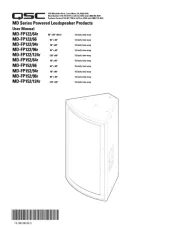
28 Maart 2025

28 Maart 2025

28 Maart 2025
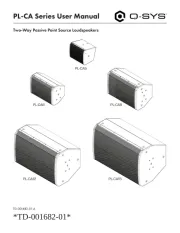
28 Maart 2025

28 Maart 2025
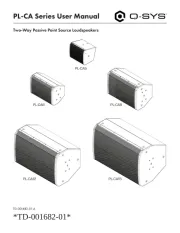
28 Maart 2025
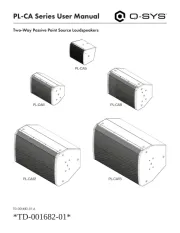
28 Maart 2025

28 Maart 2025
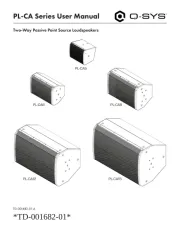
28 Maart 2025

28 Maart 2025
Handleiding Speaker
- Targus
- Nec
- Medeli
- Cleer
- MoFi
- Sylvania
- Bigben
- QFX
- Noxon
- HEYSONG
- AudioSource
- Pure
- Silvercrest
- Numark
- Eve Audio
Nieuwste handleidingen voor Speaker
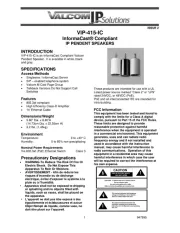
31 Juli 2025
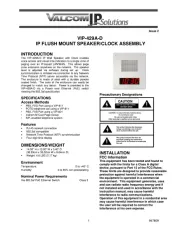
31 Juli 2025
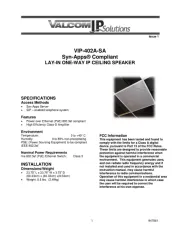
31 Juli 2025
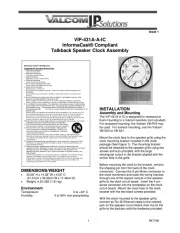
31 Juli 2025
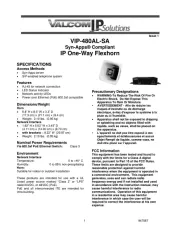
31 Juli 2025
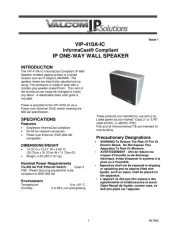
31 Juli 2025
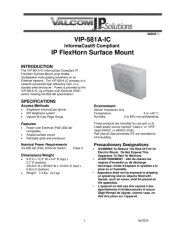
31 Juli 2025
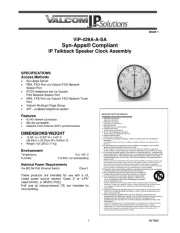
31 Juli 2025
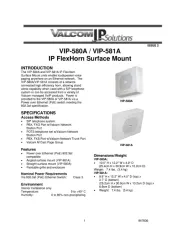
31 Juli 2025
